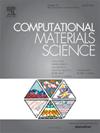Performance assessment of high-throughput Gibbs free energy predictions of crystalline solids
IF 3.1
3区 材料科学
Q2 MATERIALS SCIENCE, MULTIDISCIPLINARY
引用次数: 0
Abstract
Crystalline solids are integral to a broad range of natural science and engineering applications and their Gibbs free energy is an important parameter in modeling their thermodynamics. However, predicting for solids remains a difficult task and an under-explored field in high-throughput thermochemistry. In this work, we benchmark the performance of the newest generation of machine learning (ML) predictions, machine learning interatomic potentials (MLIPs), and density functional theory in predicting within the harmonic and quasi-harmonic approximations against experimental data from 100–2500 K and for up to 784 compounds. Furthermore, these calculations are fed to a reaction network (RN) from which experimentally informed predictions can be made. We find that predictions of made by MLIPs display promising performance but with the help of the RN, simpler methods show similar or better performance. Nonetheless, we show that much of the calculated and experimental data for still lack the accuracy and precision required for some thermodynamic modeling applications. Finally, we apply the RN to predict the room temperature Gibbs free energy of formation and find that it performs satisfactorily but that improvements need to be made before these predictions can be used as reliable indicators of thermodynamic stability in general applications.

求助全文
约1分钟内获得全文
求助全文
来源期刊

Computational Materials Science
工程技术-材料科学:综合
CiteScore
6.50
自引率
6.10%
发文量
665
审稿时长
26 days
期刊介绍:
The goal of Computational Materials Science is to report on results that provide new or unique insights into, or significantly expand our understanding of, the properties of materials or phenomena associated with their design, synthesis, processing, characterization, and utilization. To be relevant to the journal, the results should be applied or applicable to specific material systems that are discussed within the submission.
 求助内容:
求助内容: 应助结果提醒方式:
应助结果提醒方式:


